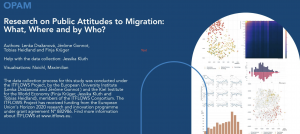If you use my data in your own research please cite the original paper as indicated and state the name and version number of the dataset. If you cannot and would like to get access to the dataset please contact me.
Research on Public Attitudes to Migration: What, Where and by Who?
We present a series of visualizations of a dataset of articles about public opinion towards migration, which underlies the meta-analysis authored by Dražanová, Gonnot, Heidland & Krüger (2021).
We analysed hundreds of scientific articles to understand more about this important and growing field of research. Our sample of consists of 529 articles. To construct it, we first settled on five base disciplines – Migration and Ethnic Studies, Economics, Political Science, Psychology, and Sociology. Using the journal-rankings provided by Clarivate (JIF), SCImago (SJR), and Google Scholar, we picked the top 30 journals from each discipline. The selection was then refined to articles with a specific focus on attitudes towards migration. Information was gathered into an accessible resource that allows users to dig into the details of scientific work on attitudes to migration. Our analysis allows us not only to see the topics for research, but also more general questions about the composition and production of the social science scholarship on attitudes to migration. We provide insights in terms of method, research question, and sample, as well as the characteristics of the authors such as where they are based and their gender.
Historical Index of Ethnic Fractionalization Dataset (HIEF), Version 2.0
Please cite as: Drazanova, Lenka. 2020. Introducing the Historical Index of Ethnic Fractionalization (HIEF) Dataset: Accounting for Longitudinal Changes in Ethnic Diversity. Journal of Open Humanities Data, 6(1), p.6. DOI: http://doi.org/10.5334/johd.16
Python script to create the Historical Index of Ethnic Fractionalization (HIEF) dataset
The Historical Index of Ethnic Fractionalization (HIEF) dataset contains an ethnic fractionalization index for 162 countries across all continents. The dataset covers annually the period 1945-2013. The ethnic fractionalization index corresponds to the probability that two randomly drawn individuals within a country are not from the same ethnic group. The new dataset is a natural extension of previous ethnic fractionalization indices and it allows its users to compare developments in ethnic fractionalization over time, as described in this blog post. The figure below shows the development of ethnic fractionalization (1945 – 2013) in a sample of European countries.
Media coverage:
Diversity and prosocial behavior (Science)
Policy documents that reference this research output:
Enhancing Defence’s Contribution to Societal Resilience in the UK: Lessons from International Approaches. RAND Corporation, 2021.
Lived Poverty on the Rise: Decade of Living-standard Gains Ends in Africa. Afrobarometer 2020.



